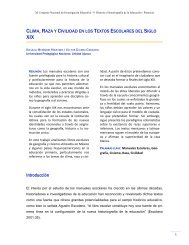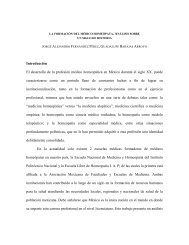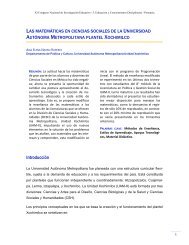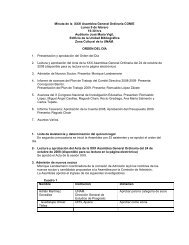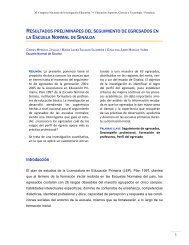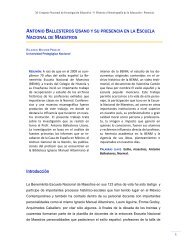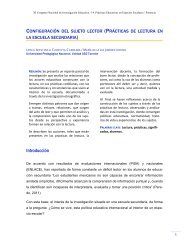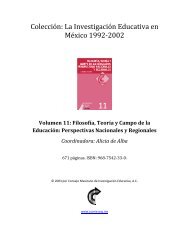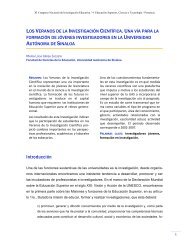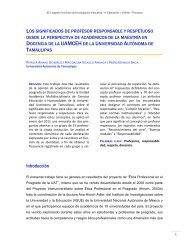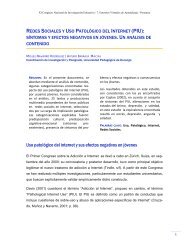- Page 1 and 2:
Colección: La Investigación Educa
- Page 3 and 4:
Coordinación general:CONSEJO MEXIC
- Page 5 and 6:
4 MARÍA DE IBARROLAvestigación Ed
- Page 7 and 8:
6 MARÍA DE IBARROLA• Limitacione
- Page 9:
8 MARÍA DE IBARROLApromovido por s
- Page 12 and 13:
3. LA EDUCACIÓN FÍSICA Y DEPORTIV
- Page 14 and 15:
Principales aspectos que han influi
- Page 16 and 17:
Soy yo y todo lo que me identifica
- Page 18 and 19:
8. LA EDUCACIÓN DE LA SEXUALIDAD P
- Page 20 and 21:
AGRADECIMIENTOSZONA CENTRO OCCIDENT
- Page 22 and 23:
CORPOREIDAD, MOVIMIENTOY EDUCACIÓN
- Page 24 and 25:
CAPÍTULO 1ANTECEDENTESRose Eisenbe
- Page 26 and 27:
Antecedentes 25El Consejo Mexicano
- Page 28 and 29:
CUADRO 1ALGUNOS ENFOQUES DEL ESTUDI
- Page 30 and 31:
Antecedentes 29mación profesional;
- Page 32 and 33:
Antecedentes 31dividió en dos part
- Page 34 and 35:
Antecedentes 33con diversas propues
- Page 36 and 37:
Antecedentes 351. Revisar las causa
- Page 38 and 39:
Antecedentes 37tiempo para continua
- Page 40 and 41:
Antecedentes 39Guadalajara: Arturo
- Page 42:
Antecedentes 41BIBLIOGRAFÍASOBRE E
- Page 45 and 46:
44 R. EISENBERG Y A. GRASSOdebates
- Page 47 and 48:
46 R. EISENBERG Y A. GRASSO[…] la
- Page 49 and 50:
48 R. EISENBERG Y A. GRASSOEn otras
- Page 51 and 52:
50 R. EISENBERG Y A. GRASSOsin mate
- Page 53 and 54:
52 R. EISENBERG Y A. GRASSOresultad
- Page 55 and 56:
54 R. EISENBERG Y A. GRASSO[…] el
- Page 57 and 58:
56 R. EISENBERG Y A. GRASSOafectivo
- Page 59 and 60:
58 R. EISENBERG Y A. GRASSOY así n
- Page 61 and 62:
60 R. EISENBERG Y A. GRASSOCuando h
- Page 63 and 64:
62 R. EISENBERG Y A. GRASSOen ausen
- Page 65 and 66:
64 R. EISENBERG Y A. GRASSOcomo el
- Page 67 and 68:
66 R. EISENBERG Y A. GRASSOmovimien
- Page 69 and 70:
68 R. EISENBERG Y A. GRASSOcorporal
- Page 71 and 72:
70 R. EISENBERG Y A. GRASSOcuando j
- Page 73 and 74:
72 R. EISENBERG Y A. GRASSOSe afirm
- Page 75 and 76:
74 R. EISENBERG Y A. GRASSOmente (p
- Page 77 and 78:
76 R. EISENBERG Y A. GRASSOción si
- Page 79 and 80:
78 R. EISENBERG Y A. GRASSOExiste u
- Page 81 and 82:
80 R. EISENBERG Y A. GRASSOsultados
- Page 83 and 84:
82 R. EISENBERG Y A. GRASSOMauss, M
- Page 86 and 87:
CAPÍTULO 3LA EDUCACIÓN FÍSICAY D
- Page 88 and 89:
La educacion física y deportiva: s
- Page 90 and 91:
La educacion física y deportiva: s
- Page 92 and 93:
La educacion física y deportiva: s
- Page 94 and 95:
La educacion física y deportiva: s
- Page 96 and 97:
La educacion física y deportiva: s
- Page 98 and 99:
La educacion física y deportiva: s
- Page 100 and 101:
La educacion física y deportiva: s
- Page 102 and 103:
La educacion física y deportiva: s
- Page 104 and 105:
La educacion física y deportiva: s
- Page 106 and 107:
La educacion física y deportiva: s
- Page 108 and 109:
La educacion física y deportiva: s
- Page 110 and 111:
La educacion física y deportiva: s
- Page 112 and 113:
La educacion física y deportiva: s
- Page 114 and 115:
La educacion física y deportiva: s
- Page 116 and 117:
La educacion física y deportiva: s
- Page 118 and 119:
La educacion física y deportiva: s
- Page 120 and 121:
La educacion física y deportiva: s
- Page 122 and 123:
La educacion física y deportiva: s
- Page 124 and 125:
La educacion física y deportiva: s
- Page 126 and 127:
La educacion física y deportiva: s
- Page 128 and 129:
La educacion física y deportiva: s
- Page 130 and 131:
La educacion física y deportiva: s
- Page 132 and 133:
La educacion física y deportiva: s
- Page 134 and 135:
La educacion física y deportiva: s
- Page 136 and 137:
La educacion física y deportiva: s
- Page 138 and 139:
La educacion física y deportiva: s
- Page 140 and 141:
La educacion física y deportiva: s
- Page 142 and 143:
La educacion física y deportiva: s
- Page 144 and 145:
La educacion física y deportiva: s
- Page 146 and 147:
La educacion física y deportiva: s
- Page 148 and 149:
La educacion física y deportiva: s
- Page 150 and 151:
La educacion física y deportiva: s
- Page 152 and 153:
La educacion física y deportiva: s
- Page 154 and 155:
La educacion física y deportiva: s
- Page 156 and 157:
La educacion física y deportiva: s
- Page 158 and 159:
La educacion física y deportiva: s
- Page 160 and 161:
La educacion física y deportiva: s
- Page 162 and 163:
La educacion física y deportiva: s
- Page 164 and 165:
La educacion física y deportiva: s
- Page 166 and 167:
La educacion física y deportiva: s
- Page 168 and 169:
La educacion física y deportiva: s
- Page 170 and 171:
La educacion física y deportiva: s
- Page 172 and 173:
La educacion física y deportiva: s
- Page 174 and 175:
La educacion física y deportiva: s
- Page 176 and 177:
La educacion física y deportiva: s
- Page 178:
Índices y bases de datosLa educaci
- Page 181 and 182:
180 A. GUERREROSe describen, a su v
- Page 183 and 184:
182 A. GUERRERODesde su inicio, la
- Page 185 and 186:
184 A. GUERREROcorrelaciona con mot
- Page 187 and 188:
186 A. GUERRERO3. De acuerdo con Ri
- Page 189 and 190:
188 A. GUERREROcreación, espontane
- Page 191 and 192:
190 A. GUERREROen juego su intelige
- Page 193 and 194:
192 A. GUERREROrécord, concepto en
- Page 195 and 196:
194 A. GUERREROcomo instrumento de
- Page 197 and 198:
196 A. GUERREROpara el ser es la fo
- Page 199 and 200:
198 A. GUERREROmotricidad. Este int
- Page 201 and 202:
200 A. GUERREROEn la historia de la
- Page 203 and 204:
202 A. GUERREROde conducta motora q
- Page 205 and 206:
204 A. GUERREROestudio e investigac
- Page 207 and 208:
206 A. GUERREROEl hombre toma conci
- Page 209 and 210:
208 A. GUERRERO(1977) expresa que l
- Page 211 and 212:
210 A. GUERREROtorno a las funcione
- Page 213 and 214:
212 A. GUERREROmecanicismo, es la d
- Page 215 and 216:
214 A. GUERREROtaciones de la motri
- Page 217 and 218:
216 A. GUERREROa) La motricidad es
- Page 219 and 220:
218 A. GUERREROEl acercamiento entr
- Page 221 and 222:
220 A. GUERREROEl turismo, ha ejerc
- Page 223 and 224:
222 A. GUERREROLas actividades fís
- Page 225 and 226:
224 A. GUERREROindependientes donde
- Page 227 and 228:
226 A. GUERREROfísica saludable y
- Page 229 and 230:
228 A. GUERREROprofundos a través
- Page 231 and 232:
230 A. GUERREROel proceso de produc
- Page 233 and 234:
232 A. GUERREROBracht, V. et al. (1
- Page 235 and 236:
234 A. GUERRERONanda, S. (1982). An
- Page 237 and 238:
236 A. GUERREROMarcotte, G. (1997).
- Page 239 and 240:
238 H. E. AQUINOASPECTOS CONCEPTUAL
- Page 241 and 242:
240 H. E. AQUINOtes al tratar de de
- Page 243 and 244:
242 H. E. AQUINODesde la perspectiv
- Page 245 and 246:
244 H. E. AQUINOeran considerados o
- Page 247 and 248:
246 H. E. AQUINOmomentos de ocio; 3
- Page 249 and 250:
248 H. E. AQUINOcotidianamente, se
- Page 251 and 252:
250 H. E. AQUINOeducación y sus ag
- Page 253 and 254:
252 H. E. AQUINOun inicio de sentid
- Page 255 and 256:
254 H. E. AQUINOúltima acepción s
- Page 257 and 258:
256 H. E. AQUINOEn la literatura me
- Page 259 and 260:
258 H. E. AQUINOdesarrollo, ambos c
- Page 261 and 262:
260 H. E. AQUINOLa pedagogía del o
- Page 263 and 264:
262 H. E. AQUINOEntre las escuelas
- Page 265 and 266:
264 H. E. AQUINOSalud Integral (EFS
- Page 267 and 268:
266 H. E. AQUINOLupe Aguilar Cortez
- Page 269 and 270:
268 H. E. AQUINOCongreso de Educaci
- Page 271 and 272:
270 H. E. AQUINOCUADRO 3AUTORES MEX
- Page 273 and 274:
272 H. E. AQUINOCUADRO 4 (CONTINUAC
- Page 275 and 276:
274 H. E. AQUINOCUADRO 4 (CONTINUAC
- Page 277 and 278:
276 H. E. AQUINOprocesos, que le po
- Page 279 and 280:
278 H. E. AQUINOEl Colegio de Méxi
- Page 282 and 283:
CAPÍTULO 6EDUCACIÓN SOMÁTICAYvá
- Page 284 and 285:
Educación somática 283Se incluye
- Page 286 and 287:
Educación somática 285Desde hace
- Page 288 and 289: Educación somática 287conciencia
- Page 290 and 291: Educación somática 289viviente: n
- Page 292 and 293: Educación somática 291Los movimie
- Page 294 and 295: Educación somática 293fesionales
- Page 296 and 297: Educación somática 295Algunos emp
- Page 298 and 299: Educación somática 297definir sus
- Page 300 and 301: Educación somática 299mundo occid
- Page 302 and 303: Educación somática 301Esta rehabi
- Page 304 and 305: Educación somática 303dudas se es
- Page 306 and 307: Educación somática 305do, en gran
- Page 308 and 309: Educación somática 307Muchas de e
- Page 310 and 311: Educación somática 309Segunda viv
- Page 312 and 313: Educación somática 311necesidad d
- Page 314 and 315: Educación somática 313mediatizada
- Page 316 and 317: Educación somática 315CUERPO VIVI
- Page 318 and 319: Educación somática 317El concepto
- Page 320 and 321: Educación somática 319juego es un
- Page 322 and 323: Educación somática 321Corporeidad
- Page 324 and 325: Educación somática 323• El niñ
- Page 326 and 327: Educación somática 325adecuadas;
- Page 328 and 329: Educación somática 327Tal vez est
- Page 330 and 331: Educación somática 329años sigue
- Page 332 and 333: Educación somática 331Therapy se
- Page 334 and 335: Educación somática 333• Esto ha
- Page 336 and 337: Educación somática 335En la actua
- Page 340 and 341: Educación somática 339Varela, F.
- Page 342 and 343: CAPÍTULO 7EDUCACIÓNDE LA EXPRESI
- Page 344 and 345: Educación de la expresión corpora
- Page 346 and 347: Educación de la expresión corpora
- Page 348 and 349: Educación de la expresión corpora
- Page 350 and 351: Educación de la expresión corpora
- Page 352 and 353: Educación de la expresión corpora
- Page 354 and 355: Educación de la expresión corpora
- Page 356 and 357: Educación de la expresión corpora
- Page 358 and 359: Educación de la expresión corpora
- Page 360 and 361: Educación de la expresión corpora
- Page 362 and 363: Educación de la expresión corpora
- Page 364 and 365: Educación de la expresión corpora
- Page 366 and 367: Educación de la expresión corpora
- Page 368 and 369: Educación de la expresión corpora
- Page 370 and 371: Educación de la expresión corpora
- Page 372 and 373: Educación de la expresión corpora
- Page 374 and 375: Educación de la expresión corpora
- Page 376 and 377: Educación de la expresión corpora
- Page 378 and 379: Educación de la expresión corpora
- Page 380 and 381: Educación de la expresión corpora
- Page 382: Educación de la expresión corpora
- Page 385 and 386: 384 J. L. ÁLVAREZ-GAYOUsin duda, s
- Page 387 and 388: 386 J. L. ÁLVAREZ-GAYOUFIGURA 1EL
- Page 389 and 390:
388 J. L. ÁLVAREZ-GAYOULuis Fuente
- Page 391 and 392:
390 J. L. ÁLVAREZ-GAYOUllejeras de
- Page 393 and 394:
392 J. L. ÁLVAREZ-GAYOUFinalmente,
- Page 395 and 396:
394 J. L. ÁLVAREZ-GAYOUque el grup
- Page 397 and 398:
396 J. L. ÁLVAREZ-GAYOUsexualidad,
- Page 399 and 400:
398 J. L. ÁLVAREZ-GAYOUCUADRO 1 (C
- Page 401 and 402:
400 J. L. ÁLVAREZ-GAYOUCUADRO 2 (C
- Page 403 and 404:
402 J. L. ÁLVAREZ-GAYOUComo puede
- Page 405 and 406:
404 J. L. ÁLVAREZ-GAYOUComo reflex
- Page 407 and 408:
406 J. L. ÁLVAREZ-GAYOUFigueróa P
- Page 409 and 410:
408 EISENBERG, TORRES, MOLINA, GUER
- Page 411 and 412:
410 EISENBERG, TORRES, MOLINA, GUER
- Page 413 and 414:
412 EISENBERG, TORRES, MOLINA, GUER
- Page 415:
414 EISENBERG, TORRES, MOLINA, GUER



